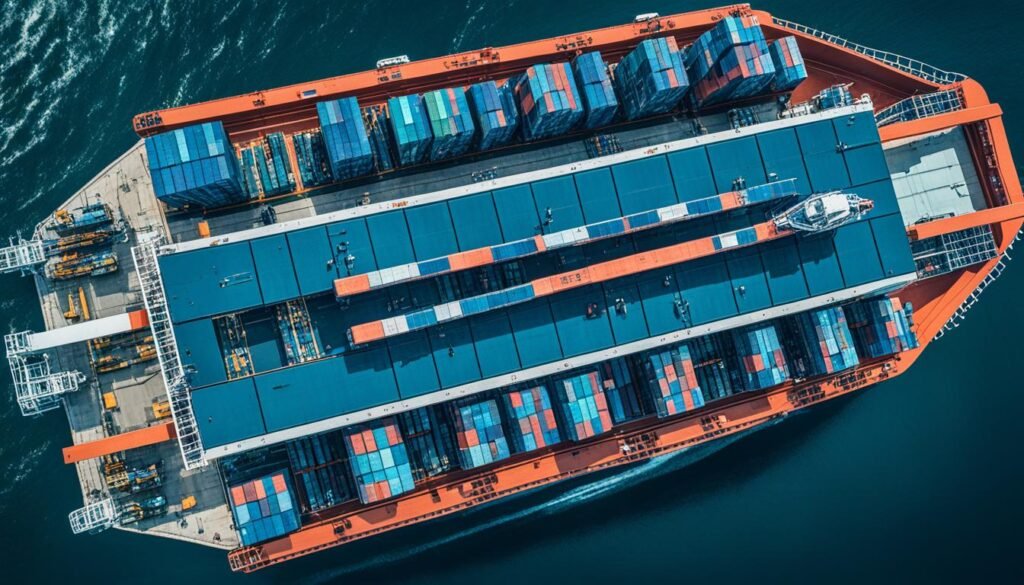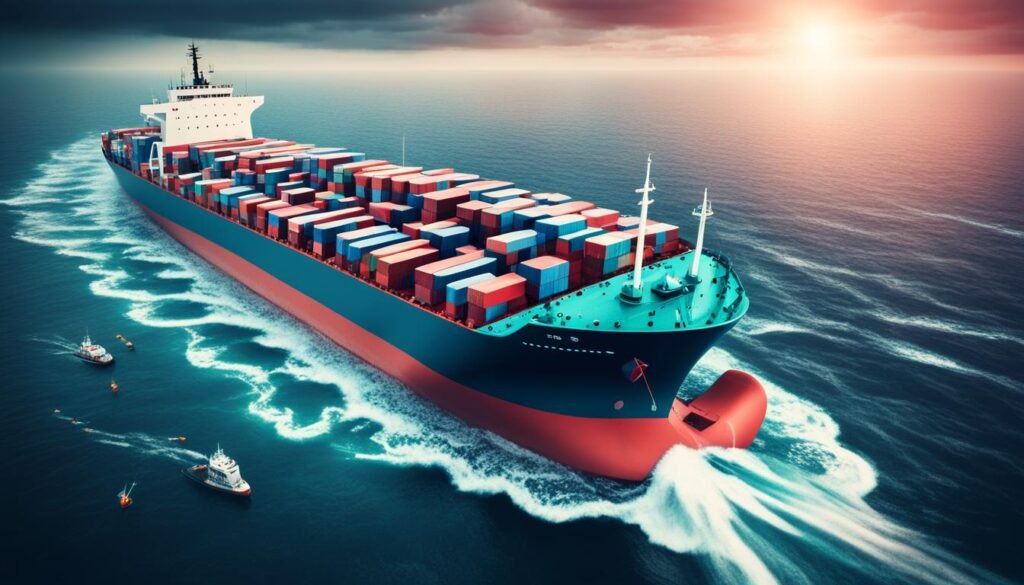As a cargo ship captain, I’ve seen how cyber attacks can ruin maritime operations. The Port of Baltimore’s shutdown, affecting thousands of jobs and disrupting transport, was a harsh lesson. It shows the shipping industry must face the cyber threat head-on.
After a cargo ship’s power failure caused the Francis Scott Key Bridge to collapse, action is urgent. The Biden administration and the European Union’s NIS2 Directive push for better cybersecurity in maritime. It’s time to strengthen our defenses.

This article offers crucial advice for the maritime community on protecting against cyber threats. We’ll cover the risks, how to protect, and strategies for detection and response. Together, we can make the shipping industry more cyber resilient.
Understanding Cargo Ship Cyber Threats
The maritime industry is getting more digital, and so are the risks. Cargo ships and maritime operations face many cyber threats. These threats come from threat actors like cybercriminals, nation-state actors, and hacktivists. They use different attack vectors to harm critical systems and disrupt operations.
Threat Actors and Common Attack Vectors
Cybercriminals often target the shipping industry with malware, ransomware, and phishing attacks. They want to make money by stealing data, extorting money, or disrupting operations. Nation-state actors use advanced methods like unauthorized access and advanced persistent threats (APTs) to gather intel or harm maritime activities for political reasons. Hacktivists might attack to highlight issues or protests.
Types of Cyber Threats Targeting Maritime Operations
- Attacks on navigation systems, making ship positioning and route planning less accurate
- Disrupting cargo tracking and monitoring systems, leading to maritime cyber incidents and shipping industry cybercrime
- Breaches of ship-to-shore communication networks, allowing data theft or unauthorized access to sensitive info
- Attacks on port infrastructure, like cargo handling equipment and access control systems, cause operational issues
It’s important to understand the changing maritime cybersecurity scene and the various shipping industry cyber risks. This knowledge helps in making strong strategies to protect port cybersecurity and container ship vulnerabilities.

Identifying Vulnerabilities in Maritime Systems
The maritime industry relies on a complex network of IT and OT systems. These systems often have common vulnerabilities that threat actors can exploit. These issues come from outdated software, poor access controls, and a lack of security updates.
It’s vital to fix these vulnerabilities to improve the shipping industry’s cybersecurity.
Common Vulnerabilities in IT and OT Systems
Cargo ships and maritime operations use many IT and OT systems. These include bridge systems, cargo management systems, and more. These systems face cyber threats because of:
- Outdated software without security updates
- Weak access controls that let unauthorized people in
- Not enough network segmentation, which spreads malware
- Not doing regular security checks and managing vulnerabilities
Risks Associated with Ship-to-Shore Interfaces
The connection between ship and shore systems is a big cybersecurity risk. This connection lets data move back and forth but can also let cyber threats in. It’s important to protect these interfaces to keep the maritime supply chain safe.
| Maritime System Vulnerabilities | Potential Cyber Threats |
|---|---|
| Outdated software and systems | Malware, unauthorized access, data breaches |
| Weak access controls and authentication | Unauthorized access, system disruptions |
| Insufficient network segmentation | Lateral movement, spread of malware |
| Ship-to-shore connectivity | Malware infiltration, data manipulation |
By fixing these vulnerabilities, the maritime industry can get better at fighting cyber attacks. This helps protect cargo ships, port infrastructure, and the shipping network.

Assessing the Risk of Cargo Ship Cyber Attacks
It’s vital to check the risk of cyber attacks on cargo ships and maritime operations. This means looking at the chance of threats, how bad an attack could be, and the risk to the company. By understanding these risks, maritime groups can make smart security choices, put in place the right safeguards, and make the maritime supply chain more resilient.
The maritime world relies a lot on digital tech and connected systems. This makes it more open to cyber threats. Things like Cyber-Physical Systems (CPS) and the Internet of Things (IoT) bring new risks to maritime vessels. This makes the cybersecurity challenges for the shipping industry even bigger.
Methods like Fault Tree Analysis, Event Tree Analysis, Failure Modes and Effects Analysis, and Bow-Tie Analysis are used a lot in the maritime field. They help figure out the risk of cargo ship cyber attacks, maritime cyber risk management, and shipping industry cyber resilience. These tools help groups see the chances and effects of cyber threats. This lets them focus on and put in place the right port cybersecurity risk analysis and container ship cyber threat assessment steps.
Studies show cyber attacks on vessels are happening more often. For example, the 2017 NotPetya malware hit Maersk hard, costing about $300 million. With more ships becoming autonomous, the need for strong cybersecurity grows. This is because they have more to attack and use advanced tech like Artificial Intelligence and Machine Learning.
| Cyber Risk Assessment Technique | Description |
|---|---|
| Fault Tree Analysis (FTA) | A deductive method that finds possible causes of a bad event. It helps analyze the system’s weak spots. |
| Event Tree Analysis (ETA) | An inductive method that starts with an event and looks at possible outcomes. It considers safety barriers and recovery steps. |
| Failure Modes and Effects Analysis (FMEA) | A proactive method that spots possible failures, looks at their effects, and finds the most important issues to fix. |
| Bow-Tie Analysis | A visual tool that combines fault tree and event tree analysis. It gives a full view of the causes, threats, and effects of a risk. |
Using these advanced risk assessment methods, maritime groups can well evaluate the risk of cargo ship cyber attacks, manage maritime cyber risks, and boost the shipping industry’s cyber resilience. This approach helps stakeholders make smart choices, focus on security spending, and put in place strong protection to keep the maritime supply chain safe.
Developing Robust Protection Measures
Protecting cargo ships and maritime operations from cargo ship cyber attack protection needs a strong, multi-layered plan. This plan is called defense-in-depth. It uses both maritime cybersecurity technical measures and port cybersecurity procedures. This makes the shipping industry’s cyber resilience strong.
Implementing Defense-in-Depth Strategies
The defense-in-depth method for container ship network security includes many technical and procedural steps. Maritime cybersecurity measures might include firewalls, systems to detect and stop intrusions, and solutions to fight viruses and malware. They also use content disarm and reconstruction (CDR) tech to stop threats from files.
Technical and Procedural Safeguards
Shipping industry cyber risk management also means having strong policies, training staff, and setting up port cybersecurity defenses and container ship operational security plans. With a defense-in-depth strategy, maritime groups can get better at stopping cargo vessel cyber incidents. They can also handle cyber threats targeting the shipping industry well.
| Technical Safeguards | Procedural Safeguards |
|---|---|
| Firewalls Intrusion Detection and Prevention Systems Antivirus and Anti-malware Solutions Content Disarm and Reconstruction (CDR) | Robust Cybersecurity Policies Comprehensive Personnel Training Incident Response and Recovery Planning |
By using a defense-in-depth strategy with technical and procedural safeguards, maritime groups can boost their cargo ship cyber attack protection and container ship network security. This makes the shipping industry’s cyber resilience stronger.
Cargo Ship Cyber Attacks: Essential Detection and Response
The maritime industry is changing fast, making maritime cyber incident detection and shipping industry cyber response more important than ever. With more technology use, there are more cyber threats. These threats include port cybersecurity incident management, container ship cyber attack response, and cargo vessel cyber resilience.
Detecting and Responding to Maritime Cyber Incidents
Being proactive and quick to respond is key to handling cyber attacks in the maritime world. Companies need strong maritime cyber incident detection systems. These systems help spot and fix threats quickly. This includes:
- Always watching IT and OT systems for odd behaviors and suspicious actions
- Having clear port cybersecurity incident management steps for reporting and dealing with incidents
- Testing and updating container ship cyber attack response plans often to keep them working well
- Training all staff on spotting and handling cargo vessel cyber resilience threats
When a cyber incident happens, having a solid shipping industry cyber response plan is key. This plan should tell how to stop the damage, fix important systems, and use what was learned to get better at cybersecurity.
Putting a big focus on maritime cyber incident detection and having a strong shipping industry cyber response helps. This way, maritime companies can lower the risks from cyber threats. It also helps keep their operations running smoothly.
Read this article on How to Protect Your Cargo from Cyber-attacks for more information.
Conclusion
Protecting cargo ships and maritime operations from cyber attacks is crucial today. In just over a month, there have been more than 10 cyber attacks on ports. This shows how fast and widespread these threats are.
These attacks have hit countries in Europe, Asia, and beyond. It’s clear that the problem is global. To fight this, we need a strong plan that covers many areas. We must keep up with new threats, fix weak spots in systems, and have good ways to protect and respond.
By focusing on cybersecurity, the shipping industry can keep its assets safe. This helps keep cargo moving smoothly and supports the global supply chain’s strength. As the industry changes, dealing with cyber threats is more important than ever.
Ports and container ships must be ready to face these challenges. By tackling these issues, the shipping industry can stay strong and secure. This way, it can handle cyber threats and keep global trade flowing smoothly.
FAQ About Cargo Ship Cyber Attacks
What are the common cyber threats facing cargo ships and maritime operations?
Cybercriminals, nation-state actors, and hacktivists pose threats to cargo ships and maritime operations. They use malware, ransomware, phishing, and unauthorized access. These threats aim to disrupt critical systems and operations.
What are the common vulnerabilities in maritime IT and OT systems?
Maritime IT and OT systems often have outdated software and poor access controls. They also lack proper network segmentation and security updates. These weaknesses make them vulnerable to attacks.
How can the ship-to-shore interface increase cybersecurity risks?
The ship-to-shore interface connects shipboard systems with shore-side infrastructure. This connection can let cyber threats in, like malware and unauthorized access. It’s important to secure these interfaces to protect the maritime supply chain.
What are the key steps in assessing the risk of cargo ship cyber attacks?
Assessing risk means looking at the likelihood and impact of threats. It also involves evaluating the risk to the organization. This helps stakeholders know where to focus security efforts.
How can maritime organizations effectively detect and respond to cyber incidents?
Effective detection and response come from strong monitoring and alert systems. Having a clear incident response plan is key. This helps contain damage, restore systems, and improve cybersecurity.
Related Posts
